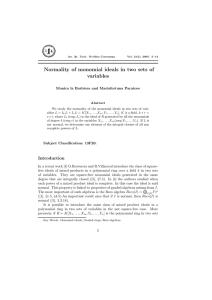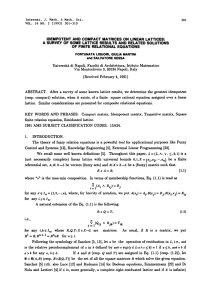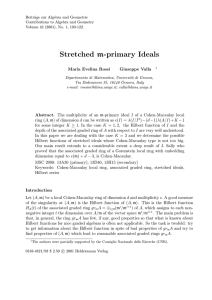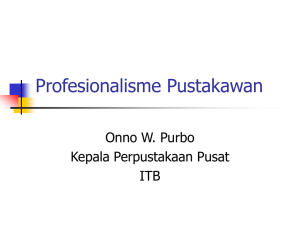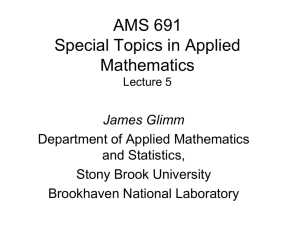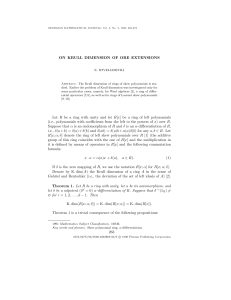FULLY SHEAF REPRESENTATIONS IDEMPOTENT NEAR-RINGS AND Department
advertisement
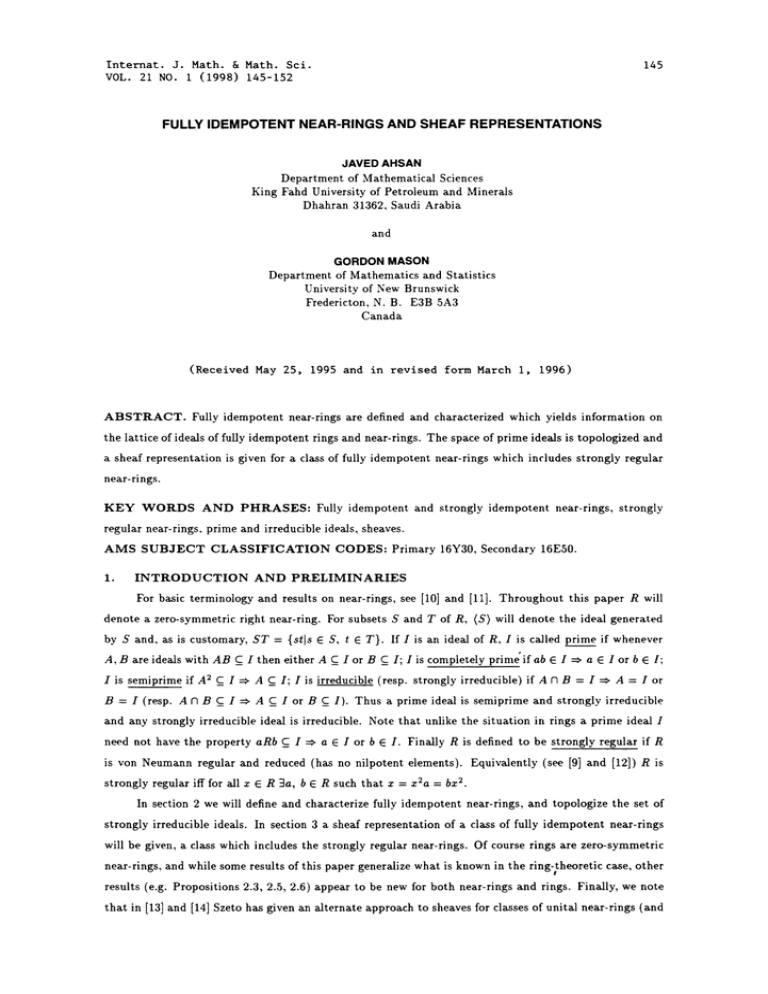
Internat. J. Math. & Math. Sci.
VOL. 21 NO.
(1998) 145-152
145
FULLY IDEMPOTENT NEAR-RINGS AND SHEAF REPRESENTATIONS
JAVED AHSAN
Department of Mathematical Sciences
King Fahd University of Petroleum and Minerals
Dhahran 31362, Saudi Arabia
and
GORDON MASON
Department of Mathematics and Statistics
University of New Brunswick
Fredericton, N. B. E3B 5A3
Canada
(Received May 25, 1995 and in revised form March i, 1996)
ABSTRACT. Fully idempotent near-rings are defined and characterized which yields information on
the lattice of ideals of fully idempotent rings and near-rings. The space of prime ideals is topologized and
a sheaf representation is given for a class of
fully idempotent near-rings which includes strongly regular
near-rings.
KEY WORDS AND PHRASES: Fully idempotent and strongly idempotent near-rings, strongly
regular near-rings, prime and irreducible ideals, sheaves.
AMS SUBJECT CLASSIFICATION CODES: Primary 16Y30, Secondary 16E50.
1.
INTRODUCTION AND PRELIMINARIES
For basic terminology and results
[10] and [11]. Throughout this paper R will
S and T of R, (S) will denote the ideal generated
on near-rings, see
denote a zero-symmetric right near-ring. For subsets
by S and, as is customary, ST
T). If I is an ideal of R, I is called prime if whenever
{stls E S,
A, B are ideals with AB C_ I then either A C_ I or B if_ I; I is completely prime’if ab I => a I or b 6 I;
I is semiprime if A C_ I => A C_ I; I is irreducible (resp. strongly irreducible) if A n B I => A I or
B
I (resp. A
B C_ I => A C_ I
or
B C_ I}. Thus
a prime ideal is semiprime and
strongly irreducible
and any strongly irreducible ideal is irreducible. Note that unlike the situation in rings a prime ideal I
need not have the property aRb C_ I => a
I
or b E
I. Finally R is defined to be strongly regular if R
Neumann regular and reduced (has no nilpotent elements). Equivalently (see [9] and [12]) R is
R 3a, b R such that x x2a bx 2.
is von
strongly regular iff for all z
In section 2
we will define and characterize fully idempotent near-rings, and topologize the set of
strongly irreducible ideals. In section 3
a sheaf
representation of a class of fully idempotent near-rings
will be given, a class which includes the strongly regular near-rings. Of course rings are zero-symmetric
near-rings, and while some results of this paper generalize what is known in the
ring-theoretic case, other
results (e.g. Propositions 2.3, 2.5, 2.6) appear to be new for both near-rings and rings. Finally, we note
that in
[13] and [14] Szeto has given an alternate approach to sheaves for classes of unital near-rings (and
146
J. AHSAN AND G. MASON
remark).
FULLY IDEMPOTENT NEAR-RINGS
see concluding
2.
A ring R is fully idempotent if each ideal I of R is idempotent, i.e.
if/
12. Several character-
Courter [7] and they play an important role in the study of (yon
Neumann) regular and V-rings [6], both of which are proper subclasses of fully idempotent rings. In
izations of these rings were given by
this section we examine the near-ring analogue of fully idempotent rings. We begin with the following
definition.
DEFINITION 2.1. A near-ring R is called fully idempotent if for each ideal I of R, I
PROPOSITION 2.2. The following assertions for a near-ring R are equivalent:
R is fully idempotent.
1.
2. For each pair of ideals
3.
I
=/I2).
^
I, J of R, I 3 J
<I J).
The set of ideals of R (ordered by inclusion) forms a lattice (,V,^) with I V J
.I (IJ) for each pair of ideals I, .] of R.
I
+J
and
(2): For each pair of ideals I,.I of R, we always have IJ C_ I t3 J. Hence
(I.]) C_ I .]. For the reverse inclusion, let a I t3 .] and let (a) be the (two-sided) ideal generated by a.
Then a (a) ((a). (a)) C_ (I J). Thus I t3 J C_ (I J). Hence I J (I J).
(2) (3)" The set of ideals of a near-ring ordered by inclusion forms a lattice under the sum and intersection of ideals ([11], Thm. 2.20). Thus for each pair of ideals I,.] of R, I V J
I + J and by the
gl
.]
.]
I
assumption, I
(I J).
(3) (2): For each pair of ideals I,.] of R, 1.1 C_ I,] always. Hence (I.]) C_ IC.]. On the other hand,
PROOF. (1)
=
^
=
since by the assumption
J
(2)
=
(I.])
is the greatest lower bound of I and J, therefore I 3 J C_
(I.1). Hence
<z J>.
(1)" Taking I
J in the hypothesis, we have I
(i2) for each
ideal I of R. Hence R is fully
idempotent.
EXAMPLES. If a near-ring is biregular (in the sense of Betsch) then, among other defining properties, for every r
R there is
the sense of Szeto if for all r
in
[9, Prop. 4] these
Re [11, p. 94]. R is biregular in
R there is a central idempotent e such that {’ r, rs,} Re. As observed
a central idempotent e such that
(r)
are biregular in the first sense too. Moreover biregular and regular near-rings are
fully idempotent. In fact, they satisfy the stronger condition that for all ideals I, J, I Cl J
IJ. For if
R is regular and x I J then z zyz for some y so z IJ. Conversely IJ C I Cl J is always true.
Similarly if R is Betsch-biregular and z I .1 then /z) Re so z re tee IJ. Note that in [14]
Szeto defined a unital near-ring R to be strongly biregular if it is regular and all idempotents are central.
These are, in fact, precisely the strongly regular near-rings as we have defined them
It will be useful in the sequel to refer to near-rings with the property I f3 J
We will call them strongly idempotent.
([9]).
IJ for all ideals I, J.
Recall that the set of all ideals of a near-ring under sum and intersection forms a complete modular
lattice (cf.
[9], Thm. 2.20}.
This lattice, however, need not be distributive. Below we show that the ideal
lattice of a fully idempotent near-ring is a complete Brouwerian, and hence distributive, lattice. A lattice
is called Brouwerian if for any a, b
,
the set of all z
satisfying
a
^ z < b contains a greatest
FULLY IDEMPOTENT NEAR-RINGS AND SHEAF REPRESENTATIONS
147
[4].
element c, the pseudo-complement of a relative to
PROPOSITION 2.:3. Let R be a fully idempotent near-ring. The set
R of ideals of R (ordered
by inclusion) is a complete Brouwerian lattice under the sum and intersection of ideals.
PROOF. As remarked above
show that
L:R
R
is a complete lattice under the sum and intersection. We now
is a Brouwerian lattice. Let
B and C be ideals of R. By Zorn’s lemma there is
an
ideal M of R which is maximal in the family S of ideals I satisfying I N B C_ C. We wish to show
M is the greatest element of S. If M
(I + M) Cl B
((I +
R we
are done. If
M
7 R
and I E S then IB C_ C so
M) B) C_ (IB + MB) c_ C. BymaximalityofM, I+M
M,i.e. I C_ M as
required.
COROLLARY.
n is distributive.
PROOF. Follows from ([4], ii.ii).
The next proposition shows that the concepts of prime, irreducible and strongly irreducible coincide
for fully idempotent near-rings. First we record the following existence result for irreducible ideals-
LEMMA 2.4. If I is an ideal of any near-ring R and if a I, there exists an irreducible ideal If
such that I C_ K and a K.
PROOF. By Zorn’s lamina, S {ideals L ]I C_ L, a /,} has maximal elements. Let K be one.
B Cl C where B and C both properly contain K then they both contain I so by maximality of K
they both contain a. But then a E B Cl C K, a contradiction.
If K
COROLLARY. Every proper ideal is contained in
PROPOSITION 2.5. Let R be
a proper irreducible ideal.
a fully idempotent near-ring and let
P be
an ideal of
R. Then
the following assertions are equivalent"
1. P is irreducible.
2. P is strongly irreducible.
3. P is prime.
PROOF. As (3)
= (2) = (1) is clear, it suffices to show that (1) = (3).
ideals I,J of R. Since R is fully idempotent, I Cl J
IIJ} by
Suppose IJ C_ P for
Proposition 2.2. On the other hand,
P. Since R is
IJ C_ P implies that {I J} C_ P. Hence IN J C_ P. This implies that (ICl J)+P
Hence
of
the
ideal
lattice
distributive.
is
R
to
the
2.3,
then
Proposition
corollary
by
fully idempotent
P
(I C J) + P
I _C P
(I + P) N (J + P). Since P is irreducible, I + P
P or J + P
or J C_ P. Hence P is a prime ideal.
PROPOSITION 2.6. Let R be a fully idempotent near-ring and
under the sum and intersection of ideals. Then the set
L:
P. This implies that
be the ideal lattice of R
BR of direct summands of R is a Boolean sublattice
of /.
-
PROOF. The proposition will follow if we show that the sum and intersection of summands of R
are direct summands of R, then A
A A2 are direct
summands of R. Let B: and B2 be the cosummands of A: and A, respectively, that is, A 4- B R and
1,2. We show that A: / A is a summand with B B as its cosummand. Suppose
ACB (0); for
are summands of R; that is, if A and
I
(B B2)4-A 4-A
R and let z
A2
R,
z
A and
I. By Lemma 2.4 there is an irreducible (hence by Proposi-
tion 2.5 a strongly irreducible) ideal P such that I C_
P, x
P. Then B B2 C_ P so B: (say) C_ P. Since
I8
J. AHSKN AND G. MASON
R, A1 gP. But A1 C_IC_ Pwhichis
A1+B1
and Yk 6 A, (k 1,2). Then (Yl + y2)z glz +
Hence, by Proposition 2.2, (A1 + A2) f3 (B1 f3 B2)
y2z
6
A1B1 + A2B2
C (A1 t3 B1)
(0). Therefore A1 + As
+ (A2VI B)
with
(B1CIB2) as its cosummand. Using an identical argument, we can show that A1 tq A2
with
B1 + B2
We
(0).
is a direct summand of
R
is a summand
as its cosummand.
now prove the following characterization theorem for fully idempotent near-rings.
THEOREM 2.7. The following are equivalent:
R is fully idempotent.
2. Every proper ideal is the intersection of the prime ideals containing it.
PROOF. (1)
(2). First note that if R is fully idempotent every ideal is contained in some
prime ideal by the corollary to Lemma 2.4, and Proposition 2.5. Let P be the primes containing I so
I C_ tqP. Conversely if a I there exists a prime ideal P with I C_ P and a P.
(2) (1). Let I be an ideal of R. If (I 2) R then I (12). If (I s) # R then I C_ (I 2) f3P C P so
I C_ P for all a, i.e. I C_ VIPo (I2). Since (i2) C_ I we are done.
1.
COROLLARY 1. R is fully idempotent iff each ideal is semiprime [11, Prop. 2.93].
COROLLARY 2. A fully idempotent near-ring is a subdirect product of prime near-rings [11,
:2.95].
Thin.
SR denote the set of proper strongly irreducible ideals of R. Since every near-ring has minimai
prime ideals [11, Cot. 2.77], Sa is not empty. For any ideal I, define 19;
{J 6 SII g: J} and let
Let
T(Sa)
{OtlI
is an ideal of
R}.
THEOREM 2.8. The set T(SR) constitutes
ideal is strongly irreducible the assignment I
Ot
a
topology on the set
SR
and if every irreducible
is a lattice isomorphism between the lattice /R of
ideals of R and the lattice of open subsets of
PROOF. First we show that the set T(SR) forms
in every ideal, therefore 0(0)
{J fi SR (0)
a
topology on the set
SR.
Since (0) is contained
because elements of SR are proper. Now let
1911,1912
{J SR 11 f312 g J}. Now consider an arbitrar, y family (Ix)e^ of ideals of
R. Then Ot, [,.J{J SR "I J}
{J fi SR BA A such that I,\ J} {,IfiSR’I J}=Oix. Since I is an ideal of R
S/
I
J and 12
([11], Thm. 2.1),
I
R, is
J}
it follows that
_J19I
SR.
T(SR).
This shows that the set
T(SR) of subsets t9i, with
"R
T(SR) by setting (I) 19I. It is easily verified
that preserves finite intersections and arbitrary unions. Hence is a lattice homomorphism. Finally
we show that
is an isomorphism. For this purpose, we show that 11
12 1911 O i for 11,12 in
R- Suppose OI 19t. If 11 12, then x 11 such that x ( I2. Then by Lemma 2.4, there exists
an irreducible and hence a strongly irreducible ideal J of R such that 12 C_ J and x
J, i.e. 11 J.
Hence J Oil. But Oll 0i, so J fi 19h- This means that 12 J. But this is a contradiction. Hence
fi
a
topology on the set
Define
11=12.
Recall that a near-ring R is indecomposable
ideals.
([11, 2.42])
if it is not the direct sum of non-trivial
FULLY IDEMPOTENT NEAR-RINGS AND SHEAF REPRESENTATIONS
PROPOSITION 2.9. If R is
ProoF.
.
lib,call thai
1
a.d ciosl subs,ts.
idol
topological space, is
covwc, ctecl
.. .
is u ici,l
oF I.
+
"i’hor’vv, this iv.pli,s thai
-
ow, ry
irreducibl(, ideal is st rong;ly irre,tucibl,
if a.d only if it hs wo vol,.pt.y
th,w (-) i both opo. a,d clos,d iF and
,’ and (’)1
s.ch that (’)1 U
of
w,,ar-riwg i, which
a
(’).
/ nd
149
v
the,
owl.v
prop(,r
i there oxists
I-I corrOSlOnd,nce cff the preceding
(0). ti’.c’ (-) is bot.i OlWV awd cios,d i n.d only
is a direct szvwvwavzd of R. Th.s it. follows that T(.S’R) is n connect’d spa(’(, if azz(! only if
if
nowlrivial clir,ct, suwnawcls, that is.
’e ncl this sctio by discussiug near-rings i wllici c, ach irreducible
lJv Proposition 2.. ullv idevnpotnt
trlll al
ing t.o
[l,
(’]fiwese
IX]
(’h.
Pings with the st.a.t.ed proprt.v
s rongly
iclc,l is
11 this class (a.wd in this
cs,
.’
irP,ducible.
is t.ho pv’izvle spc-
show t.lvat
distPibtiw, lattice il is ,sy to
[1,
l.’vvvva 1.
. s]).
Accv’d-
a.PP pr,cisolv those, for which 11., co.clzsiow of
relnaincler Thoorev holds, a.nd a xav.iwa.tion of 1.h, proof for Pings shows thai il holds
Int.tic of idonls ar th
Exillp](’ ()[ ii(,i’-Pll wh(’h
unilnl n0nE-Pings fop whici no
P(,
o[
PllS ll(I
which haw’ a. distributive
[l 1.
homomorphic it.g’ is a ring
(’OF.
2.2].
STRONGLY IDEMPOTNT AND STRONGLY RULAR NAR-RINGS
W first
sh. or IIEP-P[II
forv,zlai, tho d,nition cff
DFINITIOY
a.v,d iwclusion v.aps.
1.o
EP
strongly iPPeduciblo (for oxa.vvpl’, dualio
oPO-lTi1ll@lPC oP-P]l 1o.
8.
llaP-PiS
T(,q) t,h(’ spectra] space). Mor, genera.lly in a.wy
v.,,t-irredcillo l,,v.ents arc,
R has
is ]ir,ct.lv
3.1. l,’l,
X Iw
of ll(,ar-rillgS on X is
A presh(,[
ol]ows:
n topological spac and let T(X) b, the lOP o[op(’
SOI,
O[
cotrava.rilli [linctor [rOlll Lhe cat.ogory T(.’)
O[ neaP-rings, that is. il consists of the dta:
th lOPy
(a) For every open set
X. there
+,xists a near-ring
I/of OlWW s,ts. h,v’, ,xist a
(b) for ew, Py inclsion 1"
t>(lr), and
near-rinR hovvnonworlhisv, p[, P(I
P( I," ),
subj+,ct to the following conditions:
I. I’()
2.
p[’r,
(0), wh,ro
I,"
I
ar(’
three open sets, lhen
if !’ is a presheaf on X. then P(I) is
ptv arc, called
wheP,
t
4. if
of
P(I) is tt, identity map. and
P(I)
3. if B’
++ is lh, evwpty set
ca, llod a
Pw Pt’ o Pv.
section of the pr,sh{.af P on the,
restriction n,al,S, for which ti,{, notation
rrlv
s,l
I; a,d th{, vvaps
is occa.sionally ,,s,d inst,,ad of
p[.(,
P(I! ). The’ pr.sh{,aF P is call,d a shea, if the following a,ddil, iona, conditio.s a,v’{, sa,tisfi{,d"
I is
an open set anti
and for all I,\. the,,
5. if I: is an
for each
t,.\la,
$
Ol,’n set,
(I,).^
a
,,1.
glv for o’,/
g;
and (I,).\^ is an open covering of I; and if there are ,,ieneuts
A such that
tr,l,
is an open covering of I: a,nd if
,.
A.it A,
P(I;)s.t. cl,
[’or each pair
thon 3rr
r.\
for ,.ach
If a preshea, satislies condition (,I) only, it is called sepa, ra,ted
[2].
$
A.
P(I )
150
J. AHSAN AND G. MASON
Next we state some preliminary lemmas. We write E(I) for the near-ring generated by all the
R-endomorphisms of the left R-group hi.
LEMMA
3.2. If R is a strongly idempotent near-ring then for every pair of ideals
I. J with .1 C_ I.
any R-homomorphism from J to I factors through J.
PROOF. Since JcI
a
alb
J. b
aa3b for a,
We now describe
JI then when J C_ I
I. Then f(a)
a sheaf of near-rings on
THEOREM 3.3. Let R be
assignment )I
E(I)
a
FR(I) defines
we have
J
af(a3b) E JI
J
JI. Also J
so ifa E J then
J.
the prime spectrum of some near-rings.
strongly idempotent near-ring in which (R, +) is abelian. The
a sheaf
F/ of near-rings
on the prime spectrum of
R.
PROOF. First we prepare the data for the existence of a presheaf. FR(I)
E(I) is a near-ring
pt[j E(I) E(J), whenever
E(I). Define PIJ(&) cilJ. Note
(in fact a ring) for every ideal I of R. We now define a restriction map:
0, C_ O1, that is, when J C_ I for ideals I,J of R. Let
6
_,a,e,
E(J) by Lemma 3.2. Clearly. pF3 is a near-ring homomorphism. Thus F, satisfies the conditions of a presheaf. We now show that FR is separated. Let I
I and suppose f, g F(I) such that
that ciI.j
fll
gix, for all A e A. For each x
tative, wecan write f(z)
Hence f
x),
f(x)+f(x2)+...+f(x,.,)
’
x+...+z, forz
I.
g(xl)+g(x2)+...+g(x,)
Since (R, +) is commu-
g(x+...+x,.,)
g(x).
Fn is separated. Finally, in order to show that F is a sheaf, we verify condition (5) in
I be an ideal of R, and suppose for each ,k,# E A, f E(I) and f, E(I,,) such
f,lIl,. Define f" I + I I + I as follows: For x I + I,, write x x + x with
g, and so
Def. 3.1. Let I
that
I, we can write x
flcI,,
I. and x I.
We now define f(x)
f(x)) + f,(x). We show that f
_
is well-defined.
Suppose
x=x+x=x’ +x,.’ Then since (R, +) is commutative, wehavex-x’ =x’ -x, II.
Hence
f(x-x) f,(x-x,). Therefore f(x,)+ f,(x,,) f(x)+ f,(x). Now suppose x I,g(I: +I)
where I is an ideal of R for some E A. Since every strongly idempotent near-ring is fully idempotent,
by the corollary to Proposition 2.3, we can write I,,D(I +I,) (I,,DI.,,)+(IVI,). Thus x /C(I +I,)
means that x (I,I.)+(I,,gI,). Hence wecan write x x+x, where x /I andx I,VI,.
Thus f(x) f.\(x,) + f,(x,) f,,(x.\) + f,,(x,)
f,,(x: + x,) f,,(x). This implies that the family
A
{I
A) is stable under finite sums. We can now define a map f
I
I which satisfies
condition (5) in Def. 3.1. Suppose z
Then
z
where
z,
+...
I.
x
+
x I. Since x belongs
to a finite sum of
I’s, by the preceding arguments,
we can suppose that x E
I for some #.
Hence
we
.f(x)
f,(x), which is well-defined since two different f, agree on x when f,(x) is correctly
defined. Clearly f e E(I) which extends each f for
A. This proves that Fn is a sheaf of near-rings.
Strongly regular near-rings satisfy the hypotheses of Theorem 3.3 (see [11, 9.159a]). Further information about these near-rings is obtained by using the work of Cornish [5]. For any prime ideal P, let
OR {xlxy 0 for some y P}. As observed in [6] any reduced zero-symmetric near-ring is a reduced
system in the sense of [5, p. 883] and so we can apply [5, Thm. 3.5] to obtain:
can define
THEOREM 3.4. For any prime ideal P of a reduced near-ring, OR is the intersection of the
minimal prime ideals contained in P. Hence P is a minimal prime iff P O p.
The next result is known in the uaital case (eg.
[11, Thm. 9.163]).
FULLY IDEMPOTENTNEAR-RINGS AND SHEAF REPRESENTATIONS
PROPOSITION 3.5. If R is strongly regular, every prime ideal is
151
a minimal prime ideal.
strongly regular near-ring are completely prime [3.
examples following Prop. 5.4]. Let x E P and choose r P. If rx 0, then xr 0 since R is reduced,
so x
Op and we are done. Ifrx 0 then rx rxsrx for some s R. Hence (r-rxsr)x 0. Let
PROOF. First note that all prime ideals in
y
r- rxsr. Then y
P
or else r
a
P). Hence x
P (since x
Ov
as required.
THEOREM 3.6. If R is strongly regular, T(PR) is Hausdorff.
PROOF. Suppose P and Q are distinct prime ideals with
for some b
a
E Q, a { P. Then a
Q. Because prime ideals are completely prime O() and
OQ
so ab
0
O(b) are disjoint open sets containing
P and Q respectively.
CONCLUDING REMARKS. As mentioned in the introduction, a different approach to sheaves
of unital zero-symmetric near-rings was taken by Szeto. He used the prime ideal spaces of the Boolean
algebra of central idempotents. In [14] he further concluded that an approach based on the prime ideal
space of R was "unlikely for a near-ring due to the fact that the sum of ideals is not necessarily an
ideal and an ideal is not necessarily embedded in a prime ideal". However, the last statement is false for
,unital near-rings
incorrect
[11,
[11,271 and 2.72] and the sum of ideals is generally defined
2.1].
to make the first statement
Theorem
REFERENCES
[1] BEHRENS, E.A., "Ring Theory,"
[2] BERDON, G.,
Academic Press, New York (1972).
"Sheaf Theory," McGraw-It, ll (1967).
[3] BIRKENMEIER, G.. HEATHERLY H. and LEE, E.,
"Prime ideals and prime radicals in near-
rings," Monatsh. Math. 117 (1994), 179-197.
[4] BIRKHOFF, G..
[5] CORNISH, W.,
"Lattice Theory," AMS Colloq. Publ.
(1954).
"Boolean orthogonalities and minimal prime ideals," Comm. Algebra 3 (1975),
859-900.
and STEWART, P., "Weakly regular algebras, Boolean orthogonalities and direct
products of integral domains," Canad. J. Math., 28 (1976), 148-153.
[6] CORNISH, W.
[7] COURTER, R., "Rings all of whose factor rings are semi-prime,"
Candd.
Math. Bull., 12 (1969),
417-426.
[8] FISHER, J.,
"yon
Neumann regular versus V-rings," Proc. Oklahoma Conf. on Ring Theory,
Marcel Dekker (1974), 101-119.
[9] MASON, G., "Strongly regular near-rings,"
Pro(:. Edinburgh Math.
[10] MELDRUM, J., "Near-rings and their links with groups,"
[11] PILZ, G., "Near-Rings," North-Holland,
Soc., 23 (1980), 27-35.
Pitman, London
Amsterdam, 2nd Ed.
(1985).
(1983).
[12] REDDY, V. and MURTY, C., "On strongly regular near-rings," Proc. Edinburgh
(1984), 61-64.
[13] SZETO, G., "On sheaf representation
Math. Soc., 27
of a biregular near-ring," Canad. Math. Bull., 20
(1977),
495-500.
[14] SZETO, G., "The sheaf representation of near-rings and its applications," Comm.
773-782.
Algebra 5 (1977),
